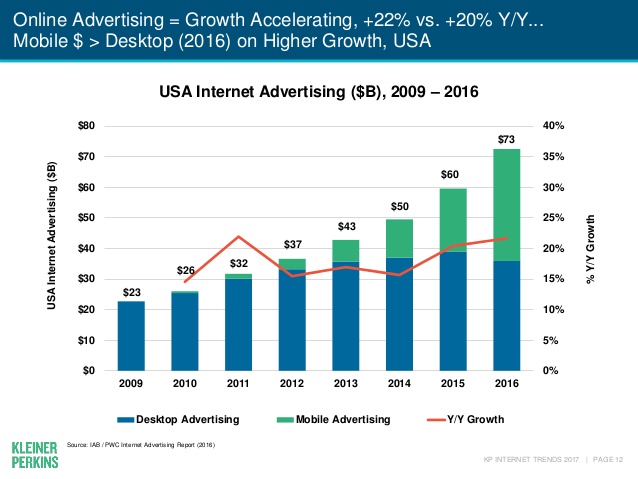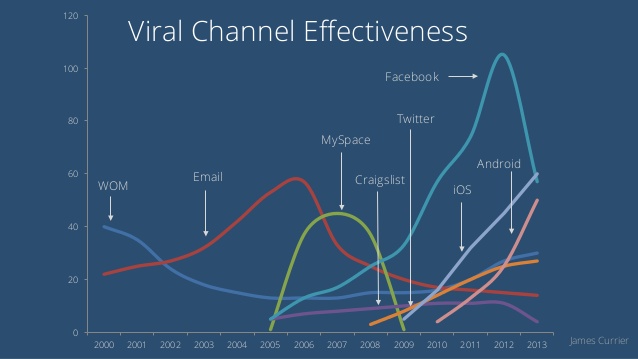Startups are cheaper to build, but more expensive to grow – here’s why

Startups should be getting cheaper to build. After all, the industry’s created several waves of innovation that’s supporting this across multiple layers in the stack:
- Open source software instead of paid developer tools
- AWS instead of your own datacenter
- Per-click ads instead of Superbowl commercials
- Off-the-shelf SaaS tools versus building your own
- App stores for efficient global distribution
Not only do a number of these trends make building new products cheap, in many cases it’s about driving the costs down to zero. If we zoom just into AWS / cloud computing, you see how a massive amount of competition is leading to significantly lower costs – even some vendors giving away their services pro bono:
As cloud providers rush to build new data centres, and battle for market share, businesses are finding that the cost of putting their computing and data storage into the online cloud is getting ever cheaper. In the past three years prices are down by around a quarter, according to Citigroup, a bank; and further significant falls look all but inevitable. Some providers, such as Microsoft, have started providing their services free to startups, in the hope of turning them into paying customers as they grow. (Economist)
However, this is opposite of what’s happening. Instead, startups are raising more capital and burning more capital to get to their Series As. It might be cheap to build the v1 of your app, but getting traction is a whole other story. Compared to a decade ago, it’s getting more expensive to get traction, while at the same time, growth is getting harder from intensive competition, consolidation, and saturation.
Why costs are rising
There are two underlying reasons for the increasing costs: Salary/comp for your team, and growth has shifted more towards paid acquisition. While the former is obvious (especially to those paying rent in San Francisco), the second is more nuanced, since it’s driven by a number of industry trends.
As we’ve said, growth is getting harder, and as a result, companies building new products are evolving their strategies away from counting on traditional channels like virality, SEO, and organic, and more towards paid acquisition to scale. Even though traction is difficult to achieve in today’s climate, venture capital is plentiful for those who hit a solid growth curve. This means that companies have an advantage when they execute well also have a natural product/channel match for paid acquisition channel. (Think high LTVs, lack of ad competition, being good at fundraising.)
What’s happening as a result
As a result of this pivot towards paid acquisition to scale, we see four trends that go along with rising costs:
- Startups are raising more money to get to traction
- Companies are trying paid marketing earlier
- There’s an increase in emphasis on paid referral programs rather than virality
- Companies are going for deeper monetization in order to open up paid channels
Let’s look at each of these trends.
1. Startups are raising more money to get to traction
More focus on paid acquisition means startups need to raise more money to raise money only once they can prove out their traction. We’re seeing more companies raising more money to get more traction before they raise, and when they do take the new round, it’s often to fund bigger and more expensive paid acquisition efforts.
The median seed round tripled from $272K to $750K between 2010 and 2016 according to analysis from Tom Tunguz over at Redpoint, and that growth extends to later rounds too. Companies across the board are raising bigger rounds, often from non-traditional investors, to drive growth for the next fundraise or for an exit (source: Quartz):

In the initial stages, this extra money enables buying early growth through testing and sub-scale campaigns to compliment organic growth. As a company scales, these bigger rounds buy you time and acquisition resources to build a defensible but expensive flywheel.
2. Companies are trying paid marketing earlier
The good news about more companies trying paid acquisition is that it’s easier than ever to experiment with paid marketing early. Self-serve ad systems are now the norm, which we can see from recent self-serve ad launches from newer platforms like Snap and Quora. Companies can test and master paid spend much earlier and run meaningful experiments with budget as low as $50. This allows an earlier and better understanding of unit economics and how to optimize the other steps in the funnel.
“Today, advertisers of all sizes expect platforms to offer them a number features as basic built-ins: self-serve, hyper-targeting, analytics, dynamic pricing. The way ad platforms are now structured with these features allows you to run small tests with sub-scale campaigns. It takes minimal time to make the creative, and it’s super easy to do testing for startups and new products.”
— Sriram Krishnan, ex-Revenue Products at Snap, Mobile Ad Platform at Facebook.
The internet advertising industry continues to grow across all channels. The number of advertisers on Facebook alone recently hit 5 million, up from 4 million just 7 months ago.
There are a couple of implications to this. First, more competition (in total spend and in number of spenders) increases the global focus on paid acquisition. As a result, everyone’s spending more.

3. More emphasis on paid referral programs rather than virality
Viral channels aren’t working as well as they used to because of the natural lifecycle that affects all acquisition channels. Today, 10 years after the introduction of biggest social networks, most viral channels have peaked:

Perhaps we’ll see the return of these social channels, as messaging platforms mature, but in the meantime, many companies are utilizing referral campaigns to juice their acquisition. Paid referral programs also help build user engagement and get companies to faster network effects because on top of bringing in more users, they bring in more users who are already connected to each other.
Dropbox’s give/get disk space was one famous early example of referral, but these days, the largest companies from Uber to Airbnb all utilize referral programs.
4. Monetize more deeply to open up channels
To support the increase in paid spend, companies need to either raise more money, or make more money. As a result, we’re seeing companies optimize for better LTVs to justify higher CAC and increased competition across the board.
Companies like Wealthfront, Breather, Credit Karma and Gusto have all hit high LTVs early in their lifecycles, and that profitability has bought them a competitive edge in acquisition as those stronger LTVs afford them higher CAC. Anecdotally, it’s been said that many Fintech companies have CACs over $1000+ to acquire a single customer.
All acquisition channels are an efficient market at some point, and this means that companies that monetize better than their competitors (either with higher LTVs or because they enjoy shorter payback periods) will be able to afford a higher CAC and subsequently out-invest those competitors. In short, better monetization is a competitive advantage for growth.
Conclusion
As you build your company, don’t underestimate the rising cost of distribution. Yes, everything’s getting cheaper from the growth of cloud computing, off-the-shelf SaaS, open-source code, and more granular and accessible performance marketing. But, growth is also getting tougher from channel saturation, better competitors, and consolidated winner-take-all platforms.
To keep growing in this type of landscape, you’ll need to think carefully about paid acquisition, deeper monetization, and how to compete in this new environment:
- New products are often sub-scale on unit economics, so they have negative LTV:CAC. Show and carve out a clear path to monetization so you can afford growth.
- No one can afford to put off paid acquisition anymore, and it’s easy to test ads on small budgets, so start as early as possible.
- Think of referral programs are another form of paid spend. You have the same CAC, but instead of giving the money to Facebook or Google, you give value to your users and their friends.
- Finally, consider ways to deepen differentiation by solving hard(er) problems and building your moat with tech.
Good luck out there!
PS. Get new updates/analysis on tech and startupsI write a high-quality, weekly newsletter covering what's happening in Silicon Valley, focused on startups, marketing, and mobile.
Views expressed in “content” (including posts, podcasts, videos) linked on this website or posted in social media and other platforms (collectively, “content distribution outlets”) are my own and are not the views of AH Capital Management, L.L.C. (“a16z”) or its respective affiliates. AH Capital Management is an investment adviser registered with the Securities and Exchange Commission. Registration as an investment adviser does not imply any special skill or training. The posts are not directed to any investors or potential investors, and do not constitute an offer to sell -- or a solicitation of an offer to buy -- any securities, and may not be used or relied upon in evaluating the merits of any investment.
The content should not be construed as or relied upon in any manner as investment, legal, tax, or other advice. You should consult your own advisers as to legal, business, tax, and other related matters concerning any investment. Any projections, estimates, forecasts, targets, prospects and/or opinions expressed in these materials are subject to change without notice and may differ or be contrary to opinions expressed by others. Any charts provided here are for informational purposes only, and should not be relied upon when making any investment decision. Certain information contained in here has been obtained from third-party sources. While taken from sources believed to be reliable, I have not independently verified such information and makes no representations about the enduring accuracy of the information or its appropriateness for a given situation. The content speaks only as of the date indicated.
Under no circumstances should any posts or other information provided on this website -- or on associated content distribution outlets -- be construed as an offer soliciting the purchase or sale of any security or interest in any pooled investment vehicle sponsored, discussed, or mentioned by a16z personnel. Nor should it be construed as an offer to provide investment advisory services; an offer to invest in an a16z-managed pooled investment vehicle will be made separately and only by means of the confidential offering documents of the specific pooled investment vehicles -- which should be read in their entirety, and only to those who, among other requirements, meet certain qualifications under federal securities laws. Such investors, defined as accredited investors and qualified purchasers, are generally deemed capable of evaluating the merits and risks of prospective investments and financial matters. There can be no assurances that a16z’s investment objectives will be achieved or investment strategies will be successful. Any investment in a vehicle managed by a16z involves a high degree of risk including the risk that the entire amount invested is lost. Any investments or portfolio companies mentioned, referred to, or described are not representative of all investments in vehicles managed by a16z and there can be no assurance that the investments will be profitable or that other investments made in the future will have similar characteristics or results. A list of investments made by funds managed by a16z is available at https://a16z.com/investments/. Excluded from this list are investments for which the issuer has not provided permission for a16z to disclose publicly as well as unannounced investments in publicly traded digital assets. Past results of Andreessen Horowitz’s investments, pooled investment vehicles, or investment strategies are not necessarily indicative of future results. Please see https://a16z.com/disclosures for additional important information.
